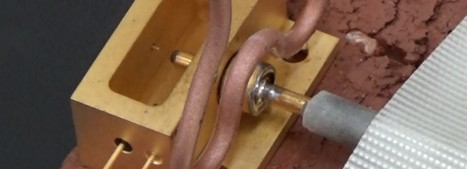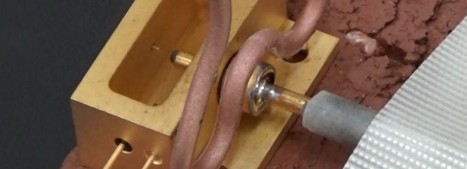Induction Brazing an Aluminum Assembly
Objective A company wanted to assess using induction heating for their aluminum assembly brazing process, and contacted THE LAB at Ambrell to utilize...
Applications
Applications: More
Applications: More

Industries:
Industries: More
Industries: More
Industries: More

Products:
Products: More
Services:
Services: More

Learn:
Learn: More
About:



THE LAB at Ambrell tested an induction heating application involving soldering ferrule and module assemblies. The end product was a component used in the fiber optics industry. The client had been using a soldering iron, but looked to induction due to its superior repeatability. A small amount of energy was used so that the client would have time to adjust the ferrule inside of the module while the solder was in a liquid state. Consequently an Ambrell EASYHEAT™ 1.2 kW induction heating system was the proper fit for this application.
A custom-designed single position multiple-turn helical coil was built to generate the required heating for this application. Ambrell's application engineers observed that the first module soldered within a minute and the second module was soldered within three minutes. This achieved the client's objectives.
Using induction for soldering offers a number of benefits. Speed, precision, repeatability and safe, flameless heating are among them. Once the process is determined, you can count on getting the same result every time. In this case, repeatability and the resulting enhanced product quality were the key factors that led to their decision to switch to induction.
This is just one example of the many applications that THE LAB at Ambrell handles on a daily basis. You can explore a full range of application notes from various industries. And, of course, we welcome you to send in your parts for free testing.

Objective A company wanted to assess using induction heating for their aluminum assembly brazing process, and contacted THE LAB at Ambrell to utilize...

Induction heating is a process that uses electromagnetic fields to heat electrically conductive materials. It has been used in numerous industries...

Induction heating, a process that uses electromagnetic induction to heat electrically conductive materials, is often thought of for large industrial...